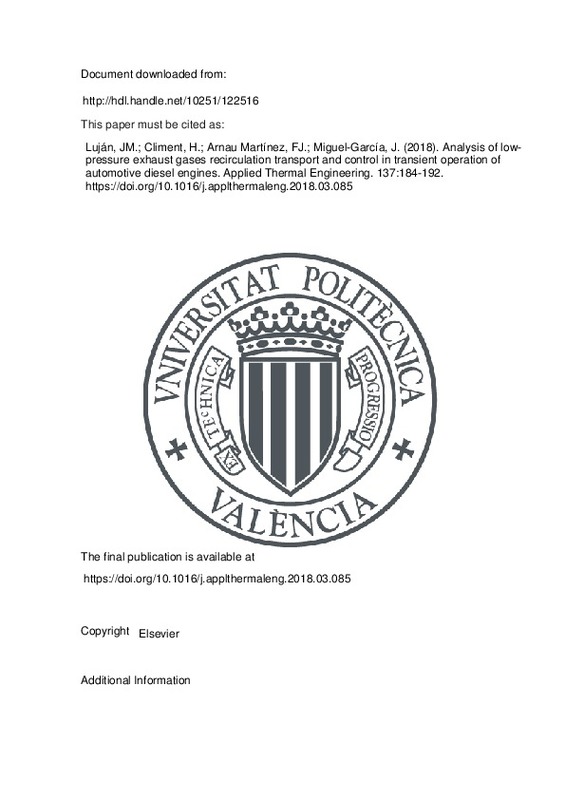JavaScript is disabled for your browser. Some features of this site may not work without it.
Buscar en RiuNet
Listar
Mi cuenta
Estadísticas
Ayuda RiuNet
Admin. UPV
Analysis of low-pressure exhaust gases recirculation transport and control in transient operation of automotive diesel engines
Mostrar el registro sencillo del ítem
Ficheros en el ítem
| dc.contributor.author | Luján, José M.
|
es_ES |
| dc.contributor.author | Climent, H.
|
es_ES |
| dc.contributor.author | Arnau Martínez, Francisco José
|
es_ES |
| dc.contributor.author | Miguel-García, Julián
|
es_ES |
| dc.date.accessioned | 2019-06-21T20:03:17Z | |
| dc.date.available | 2019-06-21T20:03:17Z | |
| dc.date.issued | 2018 | es_ES |
| dc.identifier.issn | 1359-4311 | es_ES |
| dc.identifier.uri | http://hdl.handle.net/10251/122516 | |
| dc.description.abstract | [EN] The objective of the study is to determine the behavior of the low pressure exhaust gas recirculation (LP EGR) transport phenomena in the intake manifold during engine transient operation. The investigation also analyzes the influence of the propagation of the pressure waves in the intake manifold on the engine performance. In this sense, there is a clear trade-off: long intake lines improve the engine volumetric efficiency at low engine speeds but delay the EGR transport in the system. The experiments were performed on a test bench with a 1.6 liter Euro-5 specification diesel engine. A CO2 fast tracking measurement device was setup and placed in two locations in the intake line in order to track the EGR transport in transient operation. The CO2 concentration is acquired with crank-angle resolution. Three different engine transients at constant engine speed were studied. They are extreme and worst-case scenarios in driving situations: (i) from low load to full load, (ii) from full load to low load, and (iii) from low load to medium load. In this way, it is possible to observe the behavior of the engine when: (i) leaving the EGR zone, (ii) entering into the EGR zone, and (iii) changing operating point without leaving the EGR zone. A consistent methodology that combines experimental results and a 1D model capable to predict the behavior of the engine was developed. The results obtained in this investigation show a relevant phenomenon: depending on the synchronization of the EGR and Exhaust Throttle (ET) valves, an overshoot occurs when the engine enters into EGR zone. In this study, the results show the importance of the synchronization of the valves that control the EGR strategy. Comparisons between measured and modeled CO2 concentrations lead to conclude that the EGR transport during engine transient operation is correctly predicted within a 1D engine code. | es_ES |
| dc.language | Inglés | es_ES |
| dc.publisher | Elsevier | es_ES |
| dc.relation.ispartof | Applied Thermal Engineering | es_ES |
| dc.rights | Reconocimiento - No comercial - Sin obra derivada (by-nc-nd) | es_ES |
| dc.subject | Diesel engine | es_ES |
| dc.subject | Intake line design | es_ES |
| dc.subject | LP-EGR | es_ES |
| dc.subject | Engine transient | es_ES |
| dc.subject.classification | MAQUINAS Y MOTORES TERMICOS | es_ES |
| dc.title | Analysis of low-pressure exhaust gases recirculation transport and control in transient operation of automotive diesel engines | es_ES |
| dc.type | Artículo | es_ES |
| dc.identifier.doi | 10.1016/j.applthermaleng.2018.03.085 | es_ES |
| dc.rights.accessRights | Abierto | es_ES |
| dc.contributor.affiliation | Universitat Politècnica de València. Departamento de Máquinas y Motores Térmicos - Departament de Màquines i Motors Tèrmics | es_ES |
| dc.description.bibliographicCitation | Luján, JM.; Climent, H.; Arnau Martínez, FJ.; Miguel-García, J. (2018). Analysis of low-pressure exhaust gases recirculation transport and control in transient operation of automotive diesel engines. Applied Thermal Engineering. 137:184-192. https://doi.org/10.1016/j.applthermaleng.2018.03.085 | es_ES |
| dc.description.accrualMethod | S | es_ES |
| dc.relation.publisherversion | https://doi.org/10.1016/j.applthermaleng.2018.03.085 | es_ES |
| dc.description.upvformatpinicio | 184 | es_ES |
| dc.description.upvformatpfin | 192 | es_ES |
| dc.type.version | info:eu-repo/semantics/publishedVersion | es_ES |
| dc.description.volume | 137 | es_ES |
| dc.relation.pasarela | S\356246 | es_ES |







![[Cerrado]](/themes/UPV/images/candado.png)

